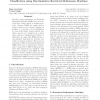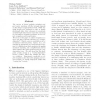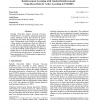98
Voted
ICML
2008
IEEE
16 years 1 months ago
2008
IEEE
Tsochantaridis et al. (2005) proposed two formulations for maximum margin training of structured spaces: margin scaling and slack scaling. While margin scaling has been extensivel...
111
Voted
ICML
2008
IEEE
16 years 1 months ago
2008
IEEE
Previous work has shown that the difficulties in learning deep generative or discriminative models can be overcome by an initial unsupervised learning step that maps inputs to use...
89
Voted
ICML
2008
IEEE
16 years 1 months ago
2008
IEEE
We have developed a new Linear Support Vector Machine (SVM) training algorithm called OCAS. Its computational effort scales linearly with the sample size. In an extensive empirica...
ICML
2008
IEEE
16 years 1 months ago
2008
IEEE
Recently, many applications for Restricted Boltzmann Machines (RBMs) have been developed for a large variety of learning problems. However, RBMs are usually used as feature extrac...
86
Voted
ICML
2008
IEEE
16 years 1 months ago
2008
IEEE
Inspired by co-training, many multi-view semi-supervised kernel methods implement the following idea: find a function in each of multiple Reproducing Kernel Hilbert Spaces (RKHSs)...
88
Voted
ICML
2008
IEEE
16 years 1 months ago
2008
IEEE
Canonical Correlation Analysis (CCA) is a well-known technique for finding the correlations between two sets of multi-dimensional variables. It projects both sets of variables int...
100
Voted
ICML
2008
IEEE
16 years 1 months ago
2008
IEEE
The success of kernel methods including support vector machines (SVMs) strongly depends on the design of appropriate kernels. While initially kernels were designed in order to han...
89
Voted
ICML
2008
IEEE
16 years 1 months ago
2008
IEEE
Policy gradient approaches are a powerful instrument for learning how to interact with the environment. Existing approaches have focused on propositional and continuous domains on...
84
Voted
ICML
2008
IEEE
16 years 1 months ago
2008
IEEE
In many applications, data appear with a huge number of instances as well as features. Linear Support Vector Machines (SVM) is one of the most popular tools to deal with such larg...
ICML
2008
IEEE
16 years 1 months ago
2008
IEEE
Partially Observable Markov Decision Processes (POMDPs) have succeeded in planning domains that require balancing actions that increase an agent's knowledge and actions that ...



